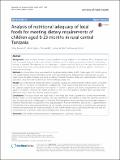Analysis of nutritional adequacy of local foods for meeting dietary requirements of children aged 6-23 months in rural central Tanzania

View/
Date
2017-08-17Author
Raymond, Jofrey
Agaba, Morris
Kassim, Neema
Jerman W, Rose
Mollay, Clara
Metadata
Show full item recordAbstract
Under nutrition remains a serious problem among children in Sub-Saharan Africa. Analysing how
diets composed of local foods could achieve nutritional goals for infants and young children in low-income
settings is essential. The objective of this study was to analyse how local foods can be used rationally and to
what extent these foods can be supplemented to achieve nutrient requirements for children aged 6 – 23 months in
resource-poor settings.
Methods: A cross-sectional study was carried out to estimate dietary intakes of 400 children aged 6-23 months using a
12-h weighed dietary record, 24-h dietary recalls, and 7-days food records. Anthropometric measurements on each
subject were also taken. Analyses were done to establish the level of nutrient intake, and nutritional status of the study
population using Microsoft Excel 2013 and ProPAN software version 2.0.
Results: The results showed that the prevalence of stunting, wasting and underweight for children aged 6–23 months
was 30–41%, 1.5–3% and 4–9%, respectively. In addition, the results showed that diets that were consumed by
the subjects comprised of local foods met vitamin A, vitamin C, protein and energy requirements for children
aged 6–23 months. However, the extent of deficit in iron, zinc and calcium in baseline diets was large and
difficult to meet under the existing feeding practices.
Conclusions: The study shows that local foods in the study area have a potential to achieve recommended
dietary intakes of some essential nutrients, and that interventions are needed to meet the required amount of
iron, zinc and calcium for children aged 6–23 months. The interventions we propose here may encourage changes in
traditional feeding habits and practices of the target population. Possible intervention options are (1) supplementation
of local foods with nutrient-dense foods that are not normally consumed in the locality (2) providing new avenues for
increasing the production and wide consumption of local nutrient-dense foods, or optimizing the way local diets are
constituted so as to achieve nutrient recommendations for infants and young children.
